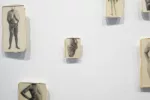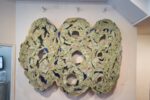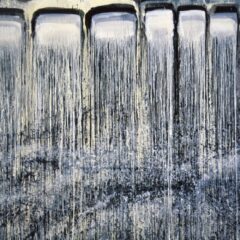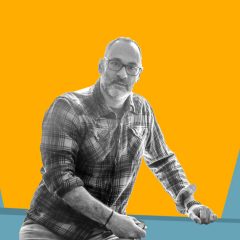Lots, an exhibition of Daniel Traub’s color photography now at The Print Center, explores intersections of devastation and beauty found in abandoned lots throughout Philadelphia.
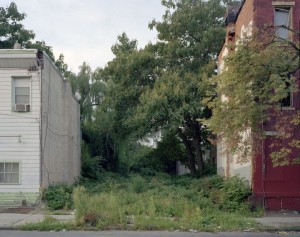
The exhibition includes eight photographs from Traub’s Lots series.
Traub has a life-long connection to these images, all dated 2010. His father, David Traub, is an architect who is dedicated to the preservation of historic and vernacular buildings throughout Philadelphia. Lily Yeh, his mother, is the founder of The Village Arts and Humanities, an arts organization known for its public art and renewal of spaces in North Philadelphia.
Visually, Traub’s work is dramatic. The sizes of the photographs are large enough to surround the viewer. The central placement of the lots in the photographs causes the viewer to immediately confront them without any visual barriers.
Traub uses a large format film camera for this work. He scans the 4” x 5” negatives and prints the photographs digitally. According to Print Center Curator John Caperton, “Daniel shoots on large format film because it is unmatched in terms of crispness and quality (still better than digital at this point). Most photographers working in color print digitally these days, which does also allow for large sizes.”
These photographs follow the philosophy behind the Japanese art of Wabi-Sabi – Traub’s work argues that there is beauty in decay and death. Peeling paint, broken windows, worn fabric, plywood, and litter all make a strong image formally. They offer a variety of unusual shapes, striking color combinations, patterns and textures. Since the lots once had buildings on them, or are sandwiched between two houses, it is easy to imagine them as interior spaces. In this situation, the landscape has come inside the space where there was once a house and viewers are reminded of the fragility of our living conditions and our connection to nature.
Spaces that seem dead at first glance are active – nature has taken over. The photographs are full of movement in the visual sense of the word. In “Lot, North Twenty Fourth and West Master Street, North Philadelphia,” ivy and lush, dark green trees roll forward in waves from the back of the lot. In “Tree, North Fifteenth and West Boston Street, North Philadelphia” (see above), the ivy and plant-life from the lot swallow the houses that border it. While this image shows one of the worst scenes in the exhibition, it is also one of the most striking images formally. Warm reds, oranges, yellows, and browns compliment the cool green areas taking over the lot and buildings. The brick, stone, wooden panels, glass, trash, and plant-life bring a variety of textures and patterns to the image. It is sad to think that these once majestic houses are now in such a state of disrepair that they are returning to nature. Yet in the decay of these lots and surrounding buildings, growing plants and trees remind viewers that revitalization is always possible.
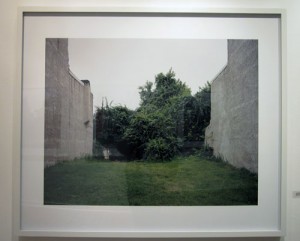
When asked whether Traub hopes to inspire social activism through these images, or whether he is more concerned with the formal and conceptual sides of his works, Caperton had this to say:
“On the one hand, I don’t think Daniel is trying to explicitly state his agenda in terms of social activism in these works. That said, while they are certainly formal explorations of space and form, he also very intentionally chose to document buildings and communities that are going through changes that are, in some cases, devastating.”
Traub chooses to title his pieces after the location of each of the Lots photographs. This choice in titling shows that Traub cares that these photographs serve as a sort of documentation. He wants the viewers to know that these are real spaces at a particular moment in time, and they are located in North and West Philadelphia. Shot during the day, these photographs have a cool, white light that clearly shows these lots as they are – nothing is idealized. These aspects of his work add an element of authenticity.
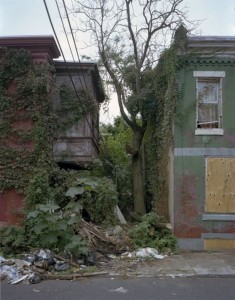
Traub uses row homes, sidewalks, and wires to frame the lots within the photographs. These frames reference the grid that occurs on flat rectangular formats, and therefore remind the viewer that the photograph is a flat object, rather than a window to a three-dimensional space. The frames in these images do not define the limits of what the viewer is looking at, but rather act as an extension of the lots. These are images of visual fields, not of objects against backgrounds.
This body of work has ties to post-minimalism because it focuses on process, contingency, chance, and the visual field. Traub’s decision to photograph vacant lots in Philadelphia was also a decision to leave a number of things about his images to chance. It also focuses more on the process of shooting photographs because of the specific parameters he chose for each of his photos to have in terms of composition, light, format and subject. Photography as a medium also invites chance into the equation – especially when film is involved. The differences between each lot were contingent upon their unique history, not any inventions set up by Traub. But unlike post-minimalist artists such as Andy Goldsworthy, Traub’s work does have a finished product – the framed photographs hanging in the Print Center.
The Print Center’s decision to show this work in their first-floor gallery is excellent because as soon as the viewer walks outside he/she is surrounded by row homes and brick townhouses that are very similar to the houses in Traub’s photographs. The Print Center is in walking distance from some of the locations Traub shot, such as the tree by the intersection of North Fifteenth and West Boston Street, and the lot on North Nineteenth Street near Cumberland Street in North Philadelphia. In this exhibition, Traub simultaneously shows the beauty, poverty, and potential in Philadelphia’s neighborhoods.
The exhibition runs through March 5.


